Roasted garlic, herby, cheesy, a combination or plain, these pull apart Sourdough Rolls are spiked with whole wheat and a bit of olive oil to make them oh so soft. After a long overnight fermentation, you can proof the rolls in the refrigerator or for a quicker proof, at room temperature. Use an active, doubled in size Sourdough Bread Starter for the fluffiest rolls! This recipe is vegetarian and vegan friendly. [ see recipe VIDEO on the recipe card ]
⭐️⭐️⭐️⭐️⭐️ Review: “These were a huge hit with my family. Your detailed instructions really helped a lot …” ~ Marina
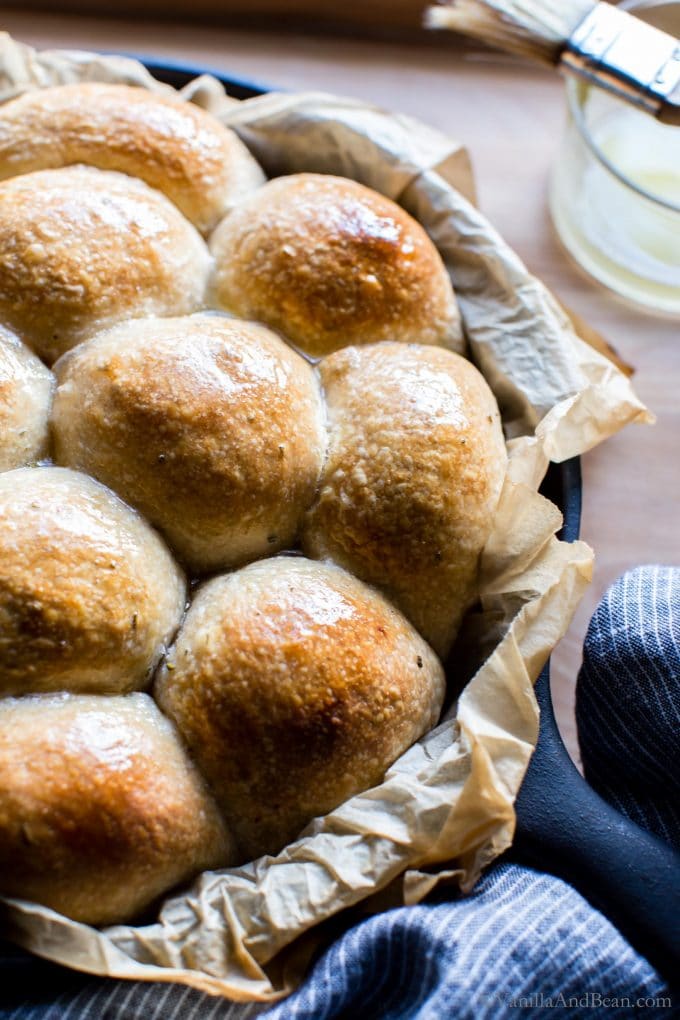
Table of Contents
Sourdough Rolls Recipe: Soft and So Fragrant
If you love Sourdough Recipes, you will enjoy these simple-to-make sourdough dinner rolls. These rolls are made with a touch of whole wheat flour for a bump of whole grains and nutty flavor, and olive oil to help create the softest, pull-apart rolls.
When I went to Pastry School, the chef always had us add a little something extra to dinner rolls. And so, for this recipe, I’m including optional add-ins to take these fluffy dinner rolls over the top, including your choice of roasted garlic (a must!), herbs like rosemary, thyme, sage, and chives, and last but not least, Parmesan!
Just like my Multigrain Sourdough Bread and Everyday Sourdough, with a little planning, these hearty sourdough bread rolls are simple to make. Best of all, they can be pulled out of the oven just before sharing the main course. But just in case, baked rolls can be frozen, thawed, and rewarmed as needed.
Related: Looking for a sourdough starter? Follow my DIY Sourdough Starter recipe.
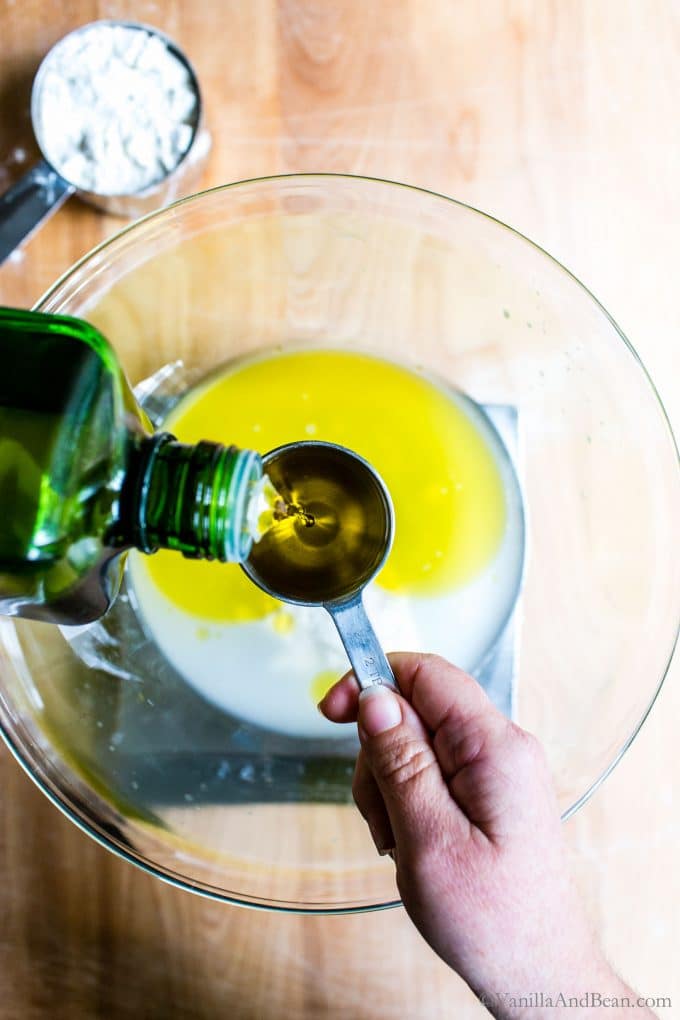
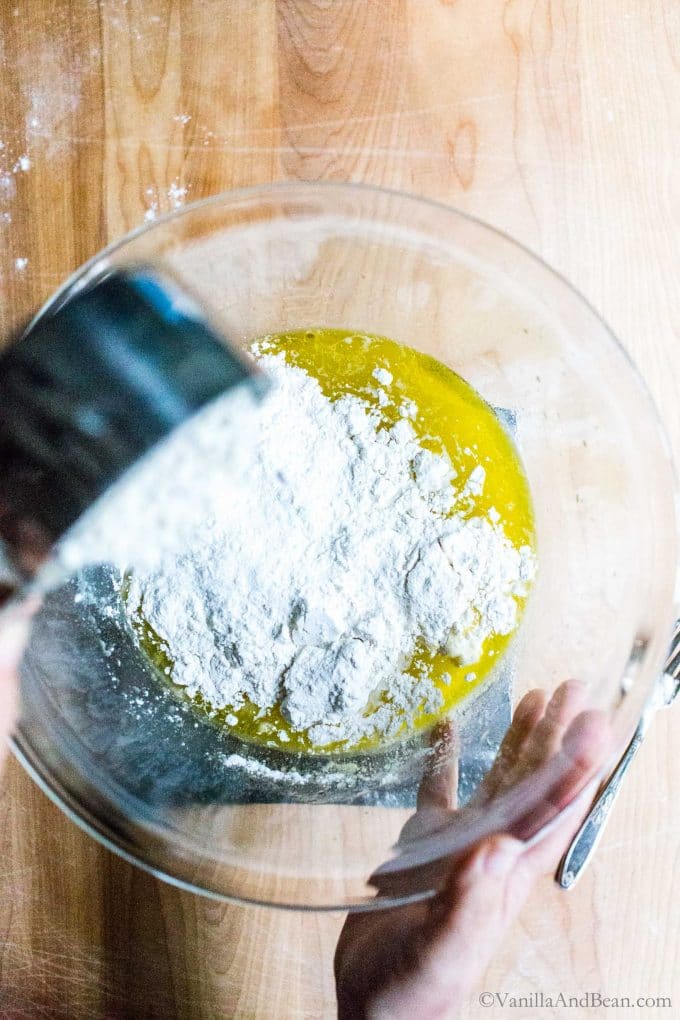
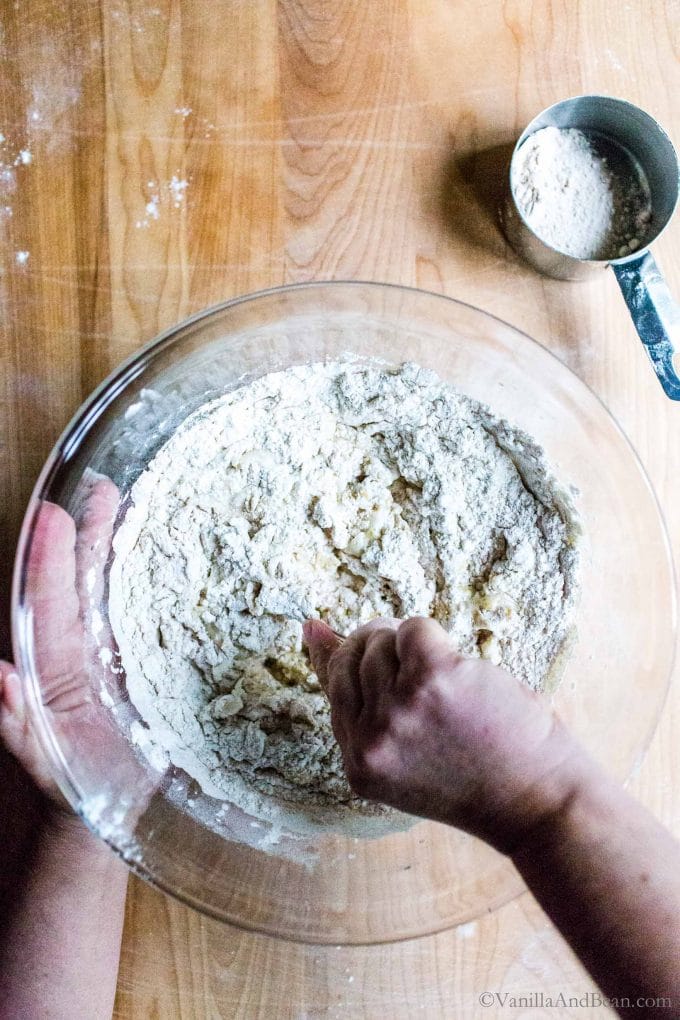
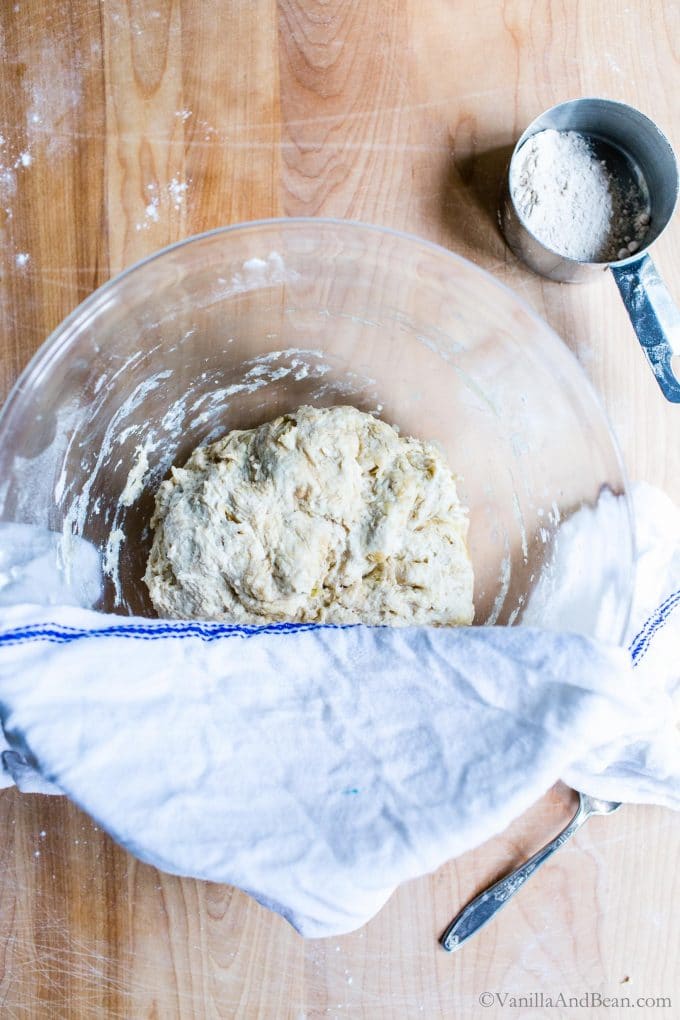
At a Glance: How to Make Sourdough Rolls
You’ll start with a fluffy, doubled-in-size sourdough starter. I have an Easy Sourdough Starter tutorial if needed. Feed your starter the day before you plan to make the rolls and store it in the refrigerator. That way the starter rises slowly and it’s less likely to miss its peak. Also, refrigerator storage offers a longer window of peak time to mix the sourdough rolls. In summary, here’s how to make these fluffy sourdough bread rolls (see recipe card for details + recipe VIDEO):
- First, mix the active sourdough starter, water, olive oil, flours and salt. Rest at room temperature for 45 minutes.
- Second, fold in the inclusions if using – roasted garlic, herbs and/or cheese. Now, at this point you can optionally divide the dough in half and make half the recipe with your favorite herbs and/or garlic, and make the over half plain – for those picky eaters! Rest for 30 minutes. Fold the dough at least one more time, twice if you can, resting 30 minutes in between.
- Third, bulk ferment for at room temperature for about 12-14 hours or until the dough doubles in size.
- Fourth, divide the dough into 12 equal pieces, shape and pan.
- Next, proof the dough. Proofing can be done at room temperature for 50-75 minutes or in the fridge for 8-12 hours, depending on your schedule.
- Last, bake on a baking sheet or cast iron skillet until golden brown.
For a shiny golden finish, just before baking, brush the rolls with egg wash or, omit the egg wash and brush the rolls with butter just as they come out of the oven (mmm melty goodness!).
Related: Got Sourdough Discard? Check out my collection of Sourdough Discard Recipes and enjoy that sourdough flavor in your favorite baked goods!
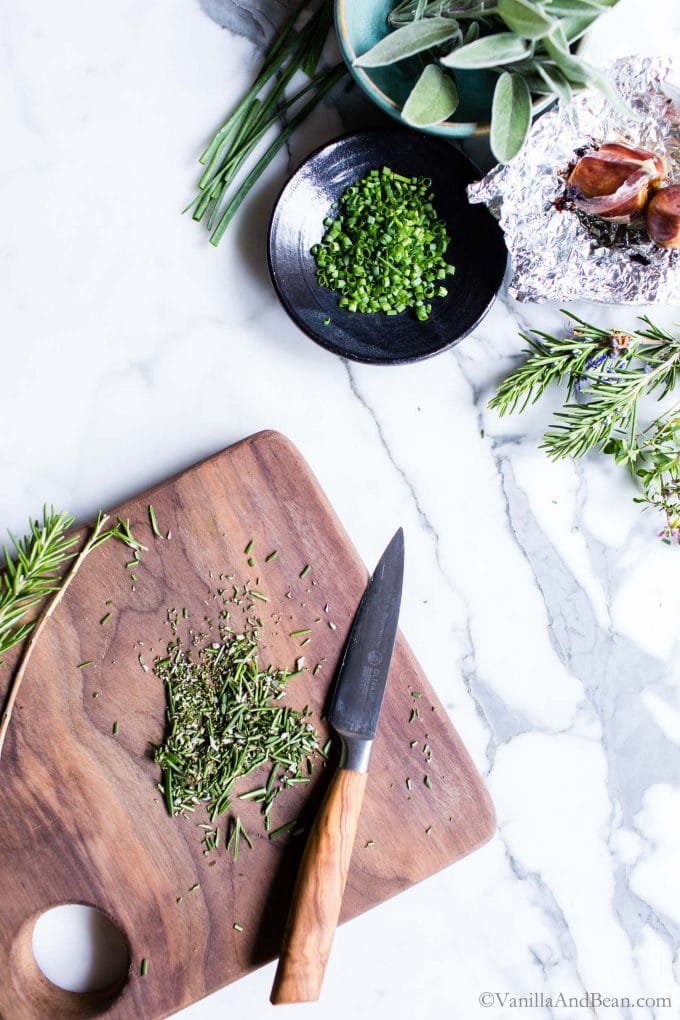
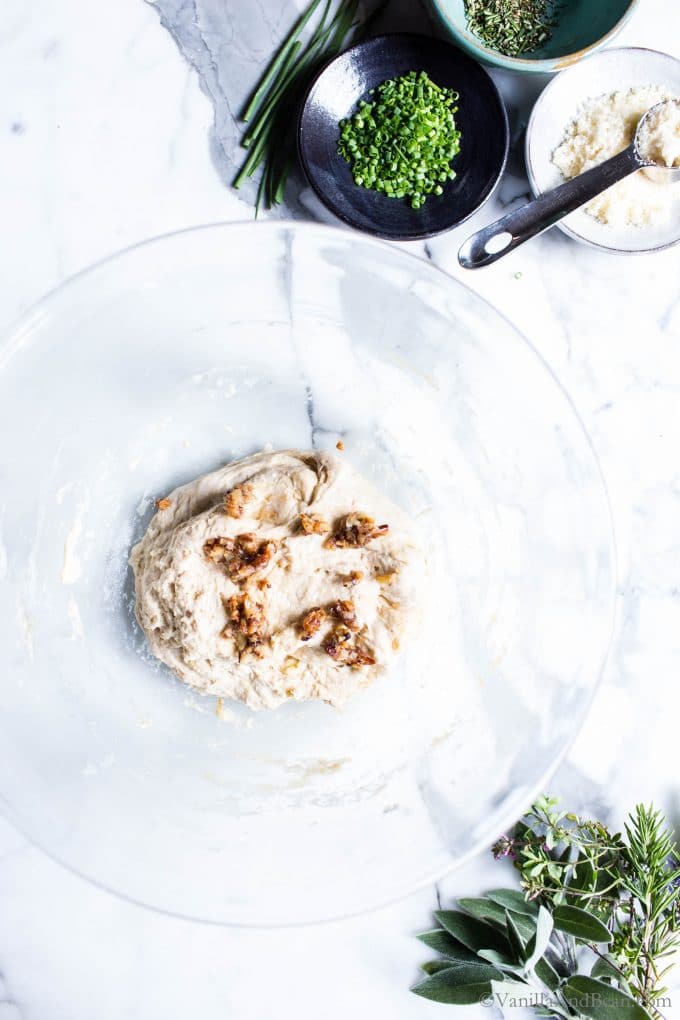
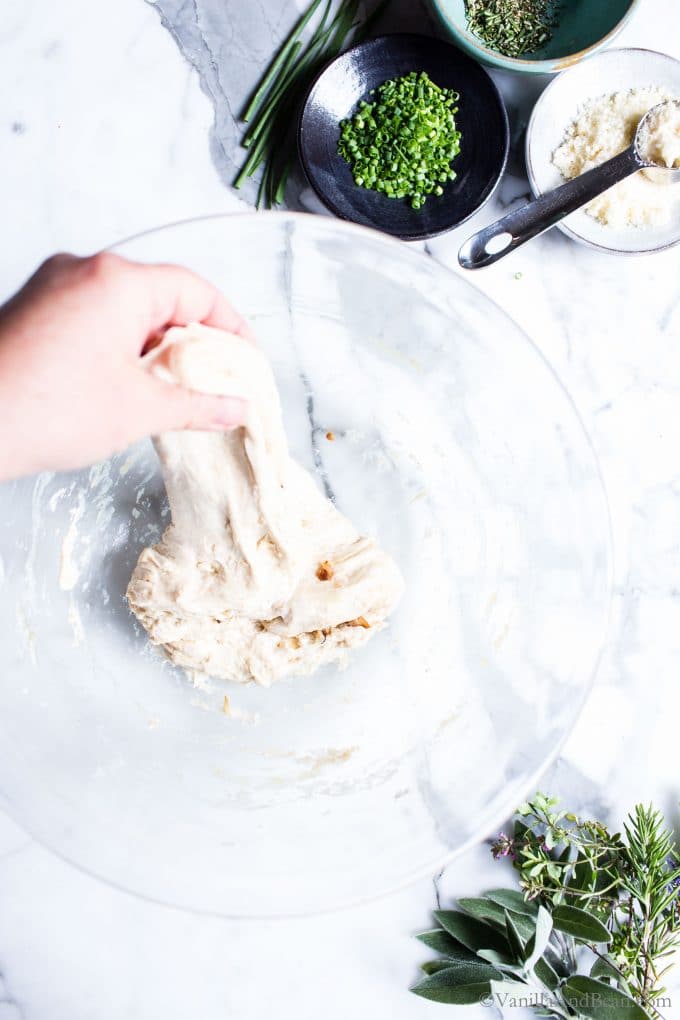
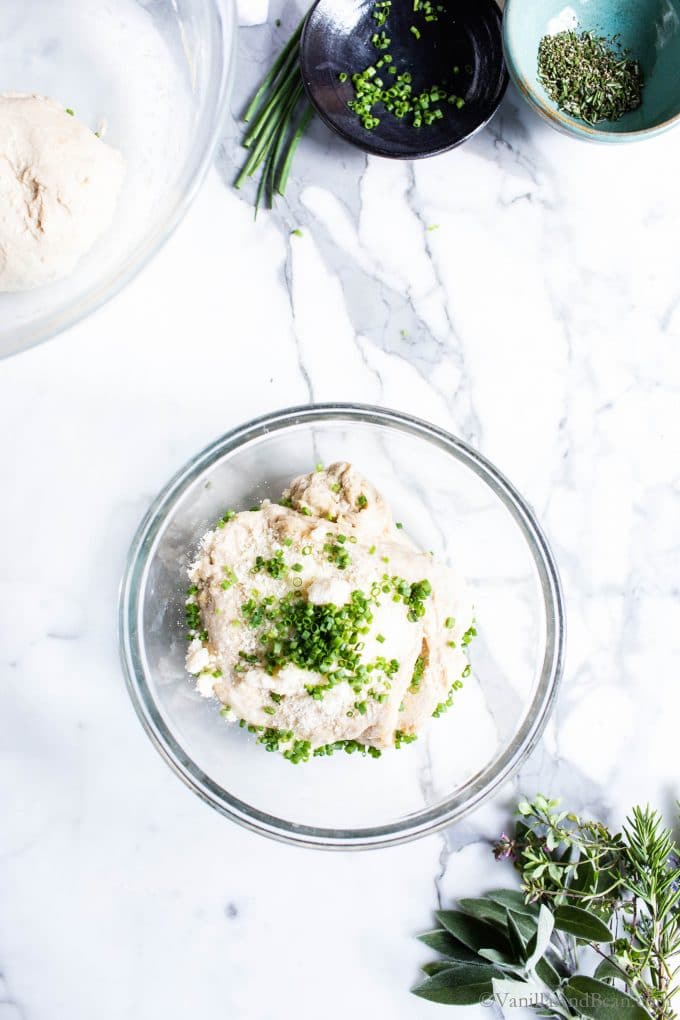
Sourdough Rolls on Your Schedule
Timing sourdough rolls just right so they’re coming out of the oven just before sharing dinner is easy; it just takes a bit of planning. Note that this timeline is in a 68F kitchen, so depending on ambient temperature, timing will vary. Here are a few example schedules to fit sourdough into your schedule:
Example One (refrigerator-proof)
I prefer this method because it’s more flexible about when you can bake.
- The evening before baking, mix the dough and bulk ferment at room temperature overnight for 12-14 hours or until the dough doubles in size.
- Divide and shape the dough early the next morning.
- Pan the rolls, cover with two moist tea towels and proof in the fridge for 8-12 hours. The rolls will be puffy but not doubled in size.
- Set the rolls out at room temperature while the oven preheats.
- Bake!
Example Two (room temperature proof)
Because this dough tends to be slow, especially in winter, room temperature proof has proven more risky for me, especially when coordinating with dinner. But it is an option. Here’s what to do:
- The evening before baking, mix the dough. Start bulk fermentation at room temperature, then move the dough to the fridge to ferment overnight before bedtime (double up on covering the dough with moist tea towels so it doesn’t dry out). Pull the dough early the next morning to fishing bulk fermentation at room temperature or until the dough doubles in size, about 8-10 hours.
- Divide and shape the dough early in the evening.
- Pan the rolls and proof at room temperature for about an hour or until puffy, but not doubled in size. That hour is a good time to whip up a hearty soup or stew!
- Bake!
Of course, whenever you want to speed bulk fermentation along, the dough can be put inside a turned-off oven with the light turned on. This will get that yeast movin!
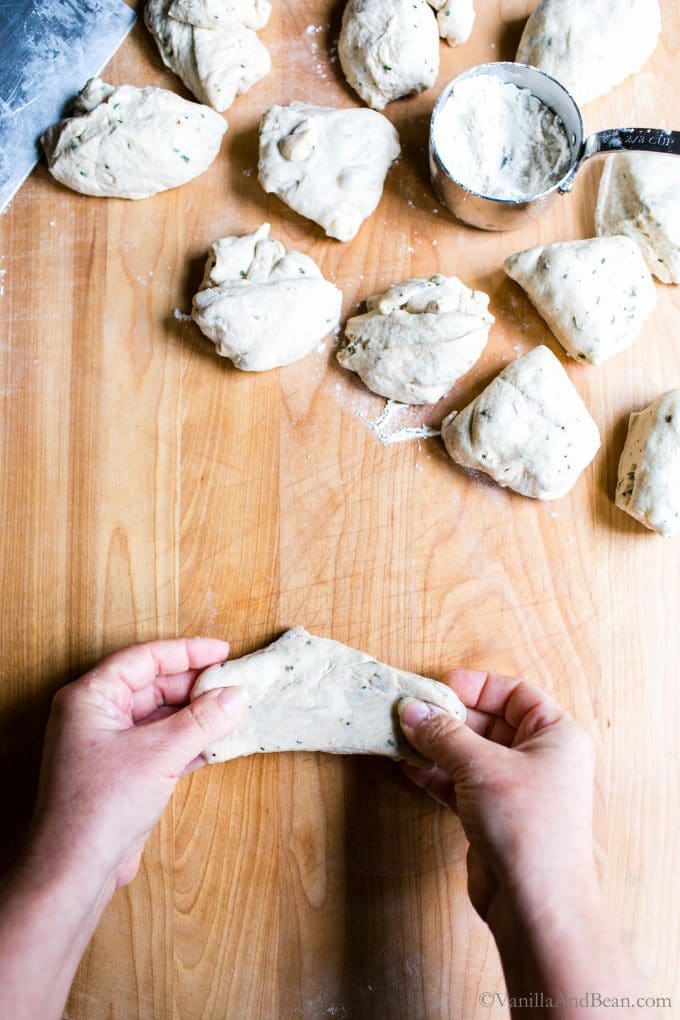
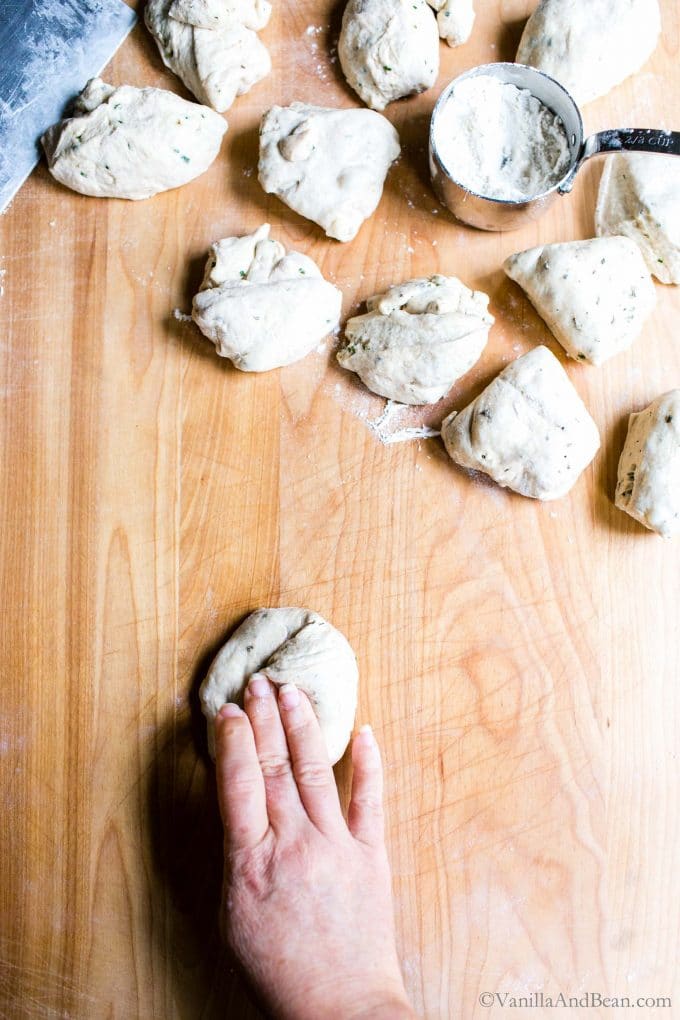
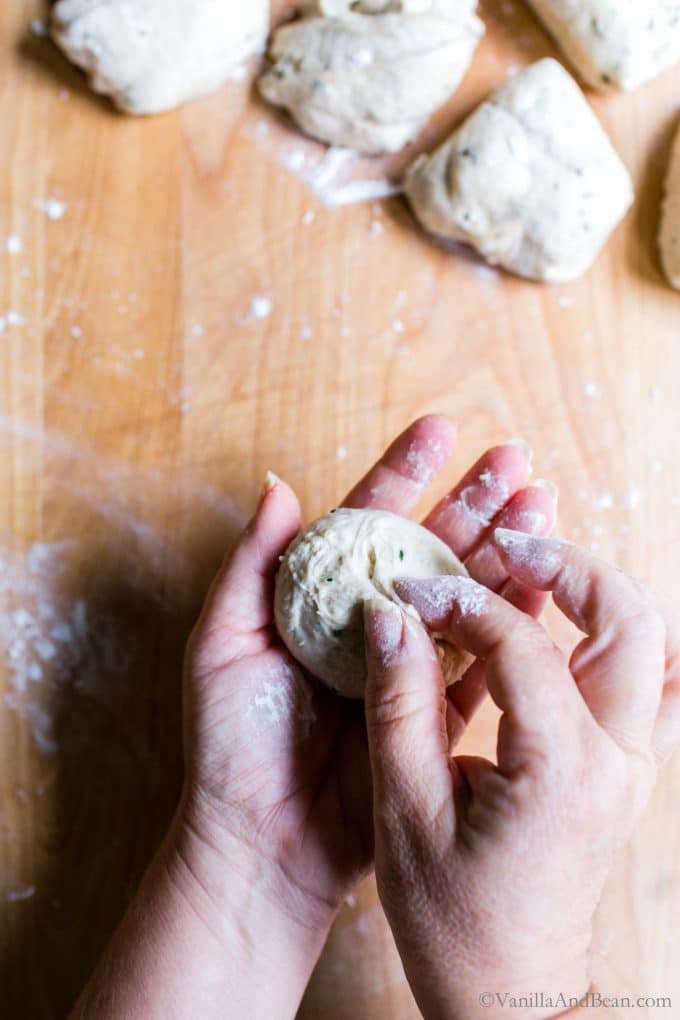
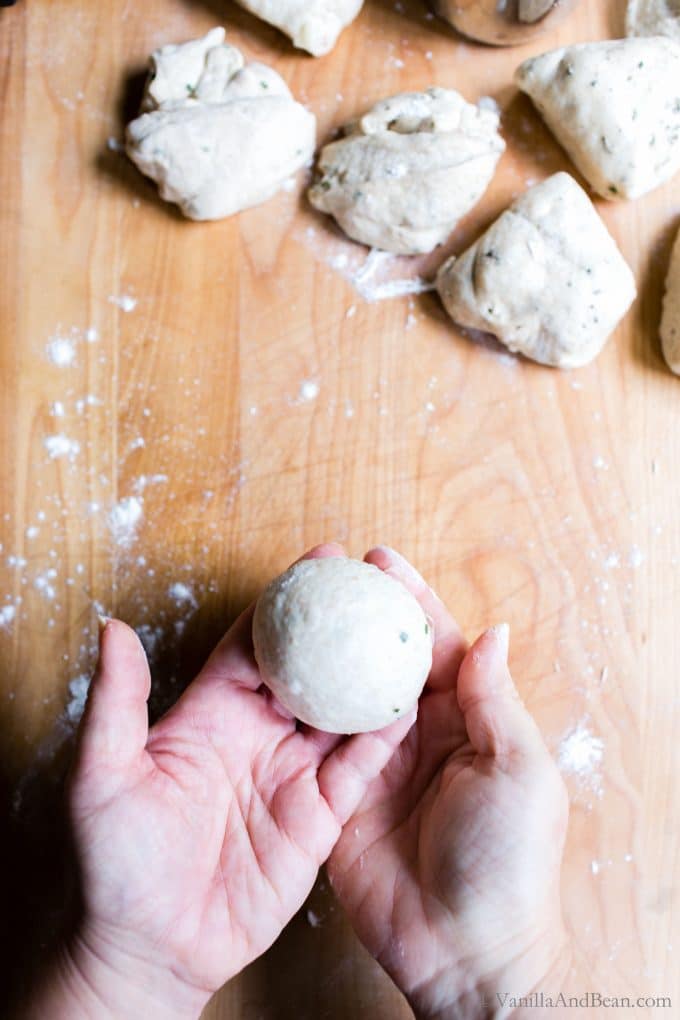
What Pan to Use for Baking Sourdough Dinner Rolls
This sourdough rolls recipe is flexible in that you can use a sheet pan or cast iron skillet for baking. I use a small sheet pan (9″x12.5″) or a 10″ skillet lined with parchment paper. The sheet pan offers a more uniform baked roll, while the skillet offers a rustic look and keeps the rolls warm for serving (!!). Additionally, the skillet browns the bottoms of the rolls more effectively than a sheet pan.
Finishing Options: Notice in the pictures below the skillet rolls are brushed with butter right out of the oven while the sheet pan rolls are brushed with egg wash just before going into the oven. The egg wash offers a shiny and a bit more golden finish.
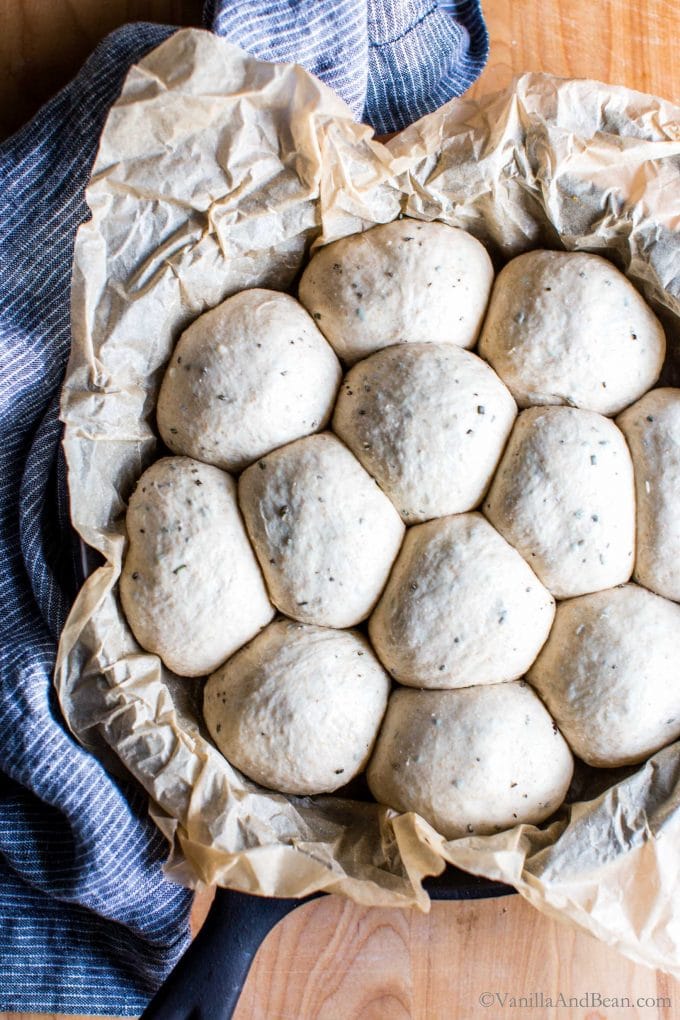
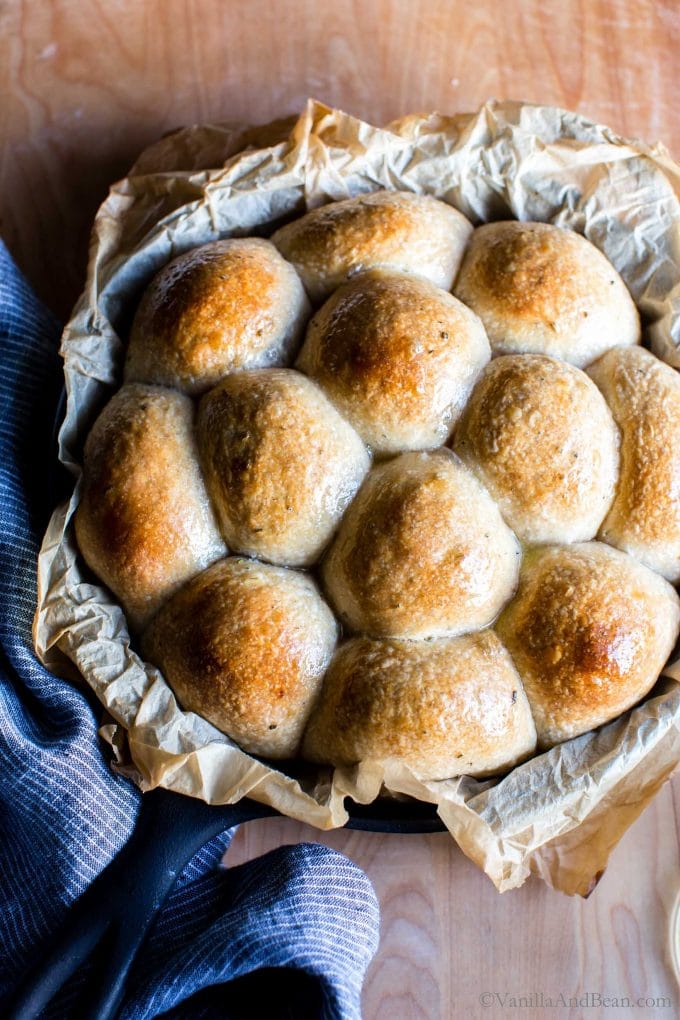
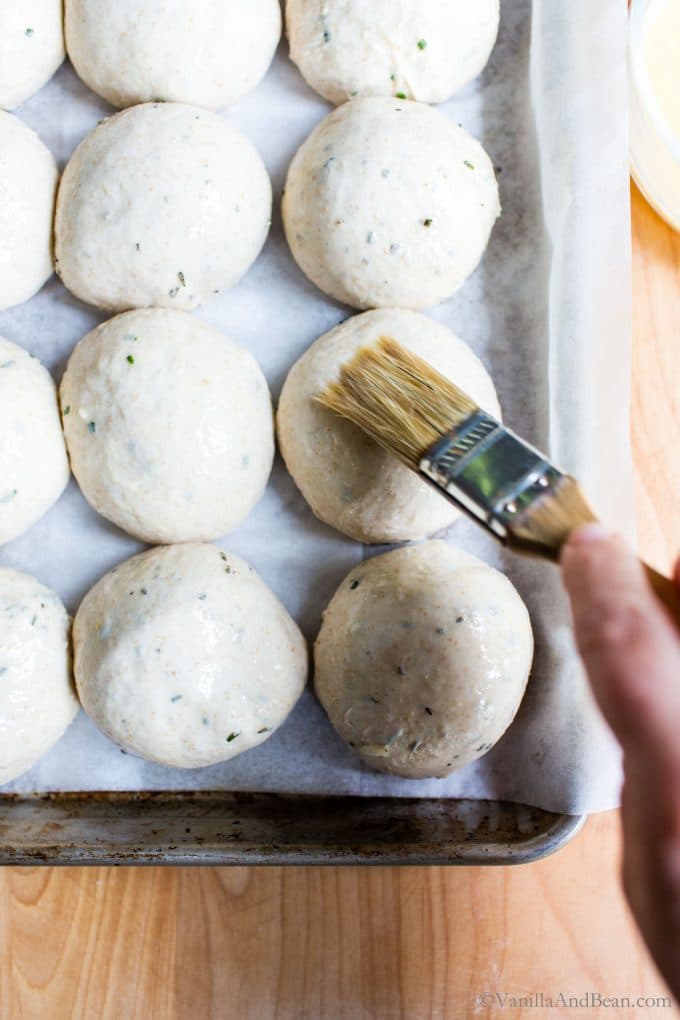
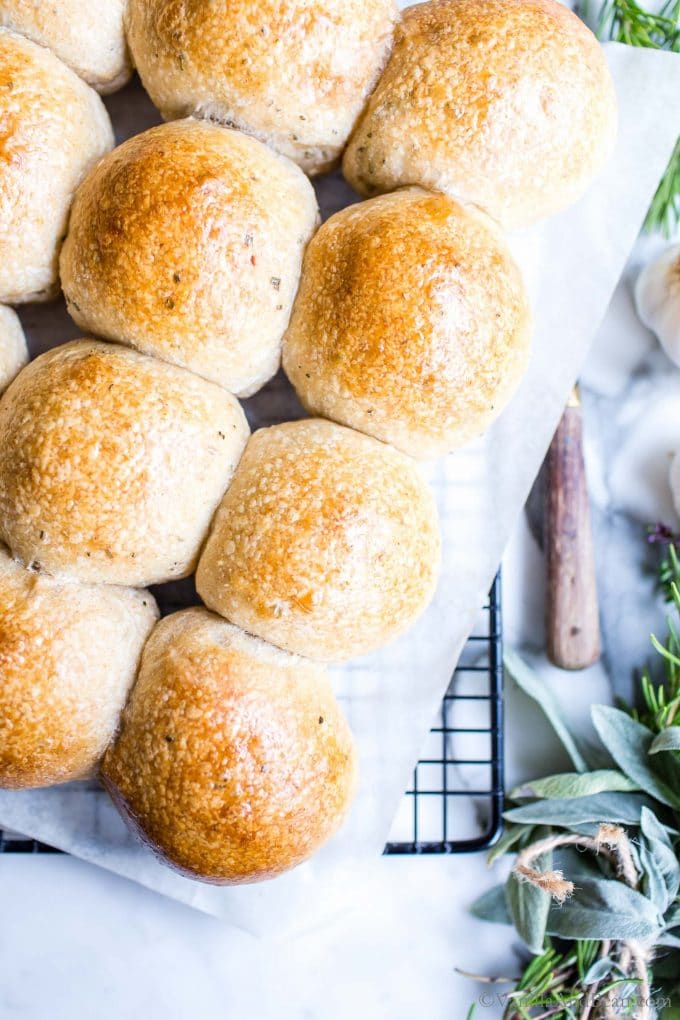
How to Know When the Proofed Dough is Ready to Bake
Do the poke test!
Simply wet your fingertip and gently press the dough in. Watch the dough closely. If the dough is proofed and ready for the oven, the dough will spring back slowly and leave a small indent. If the dough springs back right away and returns to its pre-poke state, it needs more proofing. Give the dough another 10 minutes or so, and test again.
Related: Use your starter in Sourdough Pizza and, if you have sourdough discard, give my Easy Sourdough Biscuits Recipe a go!
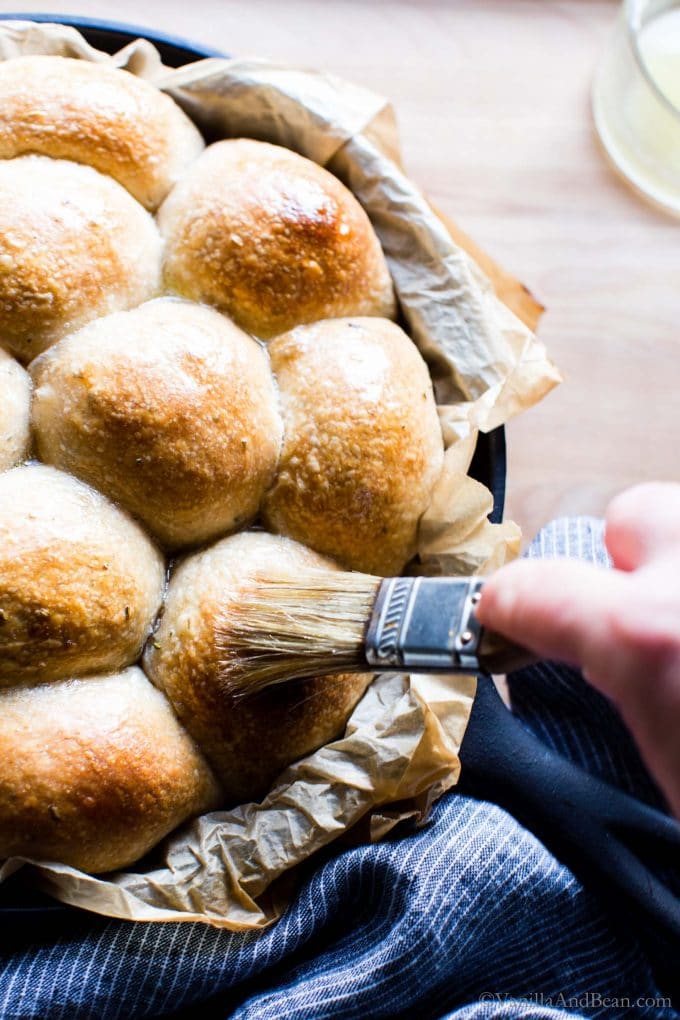
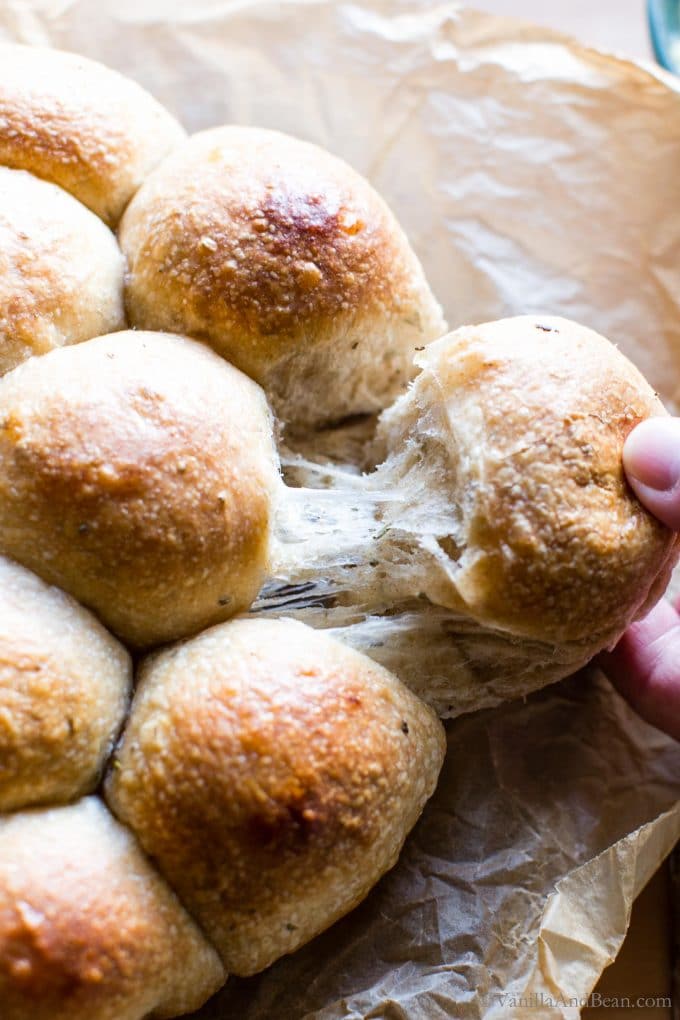
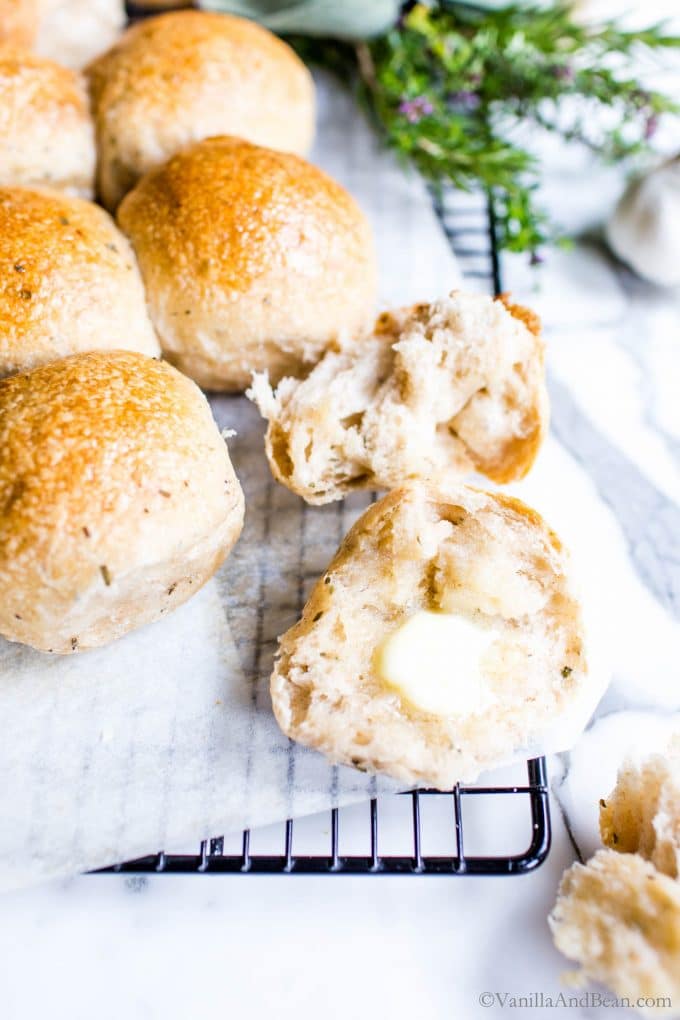
Expert Tips
- Be sure to start with a 100% hydration sourdough starter. Check out my Sourdough Bread Starter Post for a DIY guide.
- This recipe calls for Whole Wheat Bread Flour. This can sometimes be hard to find, so if unavailable, use regular Whole Wheat Flour (I use Bob’s Red Mill, organic).
- While roasted garlic is optional in this recipe, I highly recommend it if you have time. It’s simple to do, but it takes about 40 minutes to roast then another 20 minutes or so to cool.
- The herbs are optional, too, but the sky is the limit on combinations. During the holidays, I love a mix of sage, rosemary and thyme with roasted garlic. Play with the combinations to find what makes your toes curl!
- Internal Temperature: to know when the Sourdough Rolls are done baking, check the internal temperature using a digital thermometer (affiliate). When done, they should read between 190 – 205 Fahrenheit (88 – 96 Celsius).
- Kitchen Tools: I recommend a digital oven thermometer with an air probe and weighing your ingredients using a digital kitchen scale for the best outcome (affiliate links).
- These sourdough rolls, baked, are freezer friendly. Allow the rolls to cool slightly, then pull them apart, wrap in foil, then in a freezer bag. This way, you can pull a few rolls out at a time without reheating the entire batch. I messed around with freezing before baking, but the rolls never met my expectations.
More Sourdough Recipes to Love
- Sourdough Pita Bread
- Sourdough Hamburger Buns
- Sourdough Maple Oat Sandwich Bread
- Seeded Multigrain Sourdough
Soft Sourdough Rolls
Ingredients
For the Dough:
- 1/4 C (50g) Sourdough Starter previously fed, doubled in size (100% hydration)
- 1 1/4 C (300g) Water 80F
- 6 Tbs (60g) Olive Oil
- 3 C (425g) Bread Flour
- 1/2 C + 1 1/2 Tbs (100g) Whole Wheat Flour or Whole Wheat Bread Flour
- 1 3/4 tsp (12g) Fine Sea Salt
- 1 Egg or Butter (optional - for finishing)
Optional Inclusions:
- 1 Large Head of Garlic + olive oil for sprinkling *see note for how to roast
- 1 1/2 - 2 Tbs Fresh Herbs such as chives, rosemary, thyme and/or sage, chopped fine
- 6 Tbs Grated Parmesan Cheese **see note for vegetarian friendly parm
Instructions
For the Dough:
- Mix the Dough: In the evening, whisk the starter, water, and olive oil together in a large bowl with a fork. Add the flours and salt. First, mix with a fork, the dough will be shaggy. Then mix by hand, mixing, folding and pushing the dough until the flour is fully incorporated and no dry bits are present. It will seem dry at first, but the more you work the dough, the more hydrated it will become. The dough will feel stiff and it will stick to your fingers as you go. Do this for about 3-4 minutes. Use the fork to scrape the dough off your fingers. Cover bowl with a damp tea towel. Set a timer for for 45 minutes and allow the dough to rest. Now is a good time to feed/refresh your starter.
- Incorporate the Inclusions (optional): After the dough has rested, work in the inclusions. This can be garlic only, a combination of garlic and herbs or garlic and Parmesian. To do this, add 1/3 of the inclusion(s) on top of the dough (or smear the garlic paste), take a portion of the dough and fold it over and on top of itself. Add another 1/3 of the inclusion(s) and make another fold. Add the last of the inclusion(s), fold again. It will seem like a lot of added bits, but as you work the dough and as the dough develops through fermentation, the inclusions will incorporate. The dough will be stiff.Cover bowl with a damp tea towel, set a timer for 30 minutes and allow the dough to rest for 30 minutes.
- Fold the Dough: After the dough has rested, fold the dough. To do this, grab a portion of the dough while it remains in the bowl, stretch it up and fold it over, pressing your fingertips into the center of the dough. You'll notice the dough is a little less stiff and more workable at this point. Repeat, until you've worked your way around the dough. This is the first fold (after incorporating the inclusions), and you can stop here and begin bulk fermentation, but If time permits, and optimally, you'll want to repeat this fold one more time as it improves the final dough's structure and crumb. Allow for about 30 minutes between folds.
- Bulk Fermentation (first rise): After the last fold, cover the bowl with two damp tea towels and allow to rise overnight at room temperature. This will take about 8-10 hours at 70F (21C), but in a cooler kitchen the dough can take up to 12-14 hours to rise - this is the norm in my chilly kitchen 66F (18C). Use the time as a guide and not a determining factor. (***see note about retarding the dough in the refrigerator overnight, and proofing at room temperature if desired). The dough is ready when it no longer looks dense, is jiggly when the bowl is shaken, and has about doubled in size.
- Line a small sheet pan (9" x 12.5" / 22cm x 32cm) OR 10" (25cm) cast iron skillet with parchment paper. Set aside. Shape the Dough: In the morning, and with damp fingertips, coax the dough into a floured work-surface. Divide the dough into 12 pieces. If you like, weigh the pieces to ensure uniformity (about 80g or 2.75oz each). Working quickly, with a piece of dough on the work surface, pull the edges of each piece to the center to shape the dough, and pinch making a rough dough ball. Place the dough on the work surface, pinched side down, sprits a touch of water on the work surface to increase friction if needed, and gently cup your hand behind the dough ball and pull it towards you to increase surface tension. Place the dough around the edges of the skillet first, then the remaining dough balls in the center. It's okay if the dough balls are touching each other. OR if using a sheet pan, place the dough balls 3 X 4 about 1/4" (6mm) apart.
- Proof the Rolls (second rise): There's two ways to approach proofing:A. Refrigerator (long proof): Cover the pan with two damp tea towels and place in the refrigerator (the tea towels should stay moist so the dough doesn't dry out). Allow the dough to rise in the fridge for 8-12 hours. They'll become puffy but not doubled in size. When ready to bake, pull the dough from the fridge and set at room temperature while you preheat the oven. B. Room Temperature (short proof): Cover the rolls with a moist tea towel and proof at room temperature, about 50-75 minutes or until the rolls pass the poke test and look puffy but not doubled in size.
- Set an oven rack in the center of the oven. Preheat your oven to 425F (218C). Bake the Sourdough Rolls: After the oven has preheated, do the poke test to see if the rolls are proofed (see blog post above for how to). Egg Wash or Butter (optional): Crack an egg into a bowl and add one Tbs of water. Mix thoroughly and brush each dough ball with the egg wash. OR leave the egg wash off and after the rolls are baked, brush the rolls with melted butter. Place the rolls into the oven and bake at 425F (218C) for 10 minutes. Reduce the oven temperature to 375F (190C) and bake for an additional 15-17 minutes. The rolls are ready when the internal temperature of the rolls are between 205F - 210F (96C - 98C). When done, transfer to a wire rack and brush with melted butter if using. A sprinkle of flaky sea salt is quite nice too. Cool for 10 minutes before sharing. Keeping the rolls in the skillet, means they'll keep warm longer.
- Storage Notes: Sourdough is best consumed on the same day it's baked, but the rolls will last for 2-3 days stored at room temperature in a sealed plastic bag. The baked rolls freeze and rewarm beautifully. Pull the rolls apart and allow to cool completely. Wrap in foil, then in a freezer bag. Freeze for up to two weeks. Thaw at room temperature, and rewarm in a 350F oven, wrapped in foil (to keep their softness) for about 10 minutes.
Video
Notes
- After mixing the dough, incorporating the inclusions and performing the folds, place the dough in the refrigerator, in the same bowl, covered with a damp tea towel and another damp tea towel on top (this helps keep the dough moist). Bulk ferment overnight (about 8 -10 hours) in the refrigerator. Pull the dough from the refrigerator and continue bulk ferment at room temperature until the dough has doubled in size.
- Carry on with the recipe.

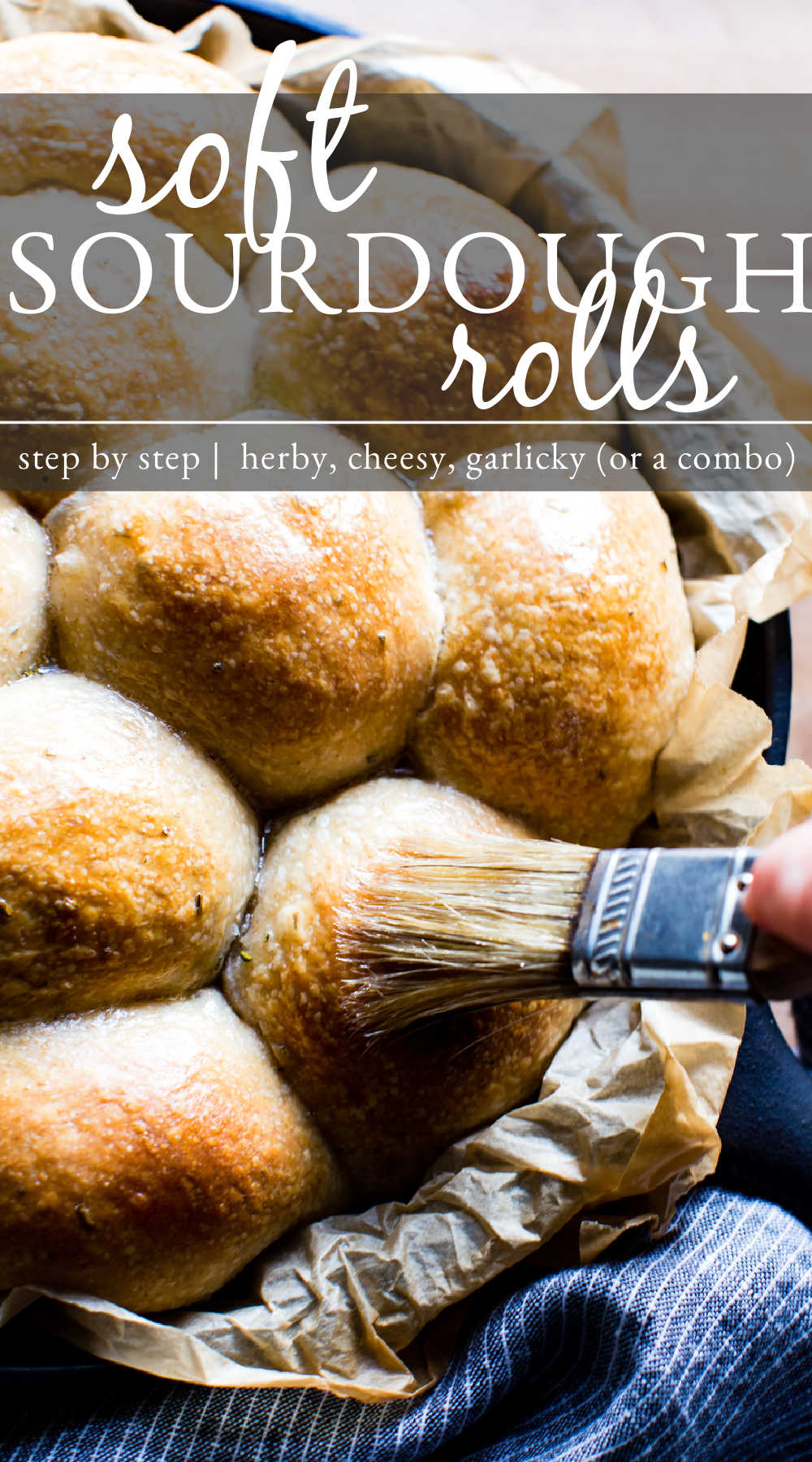
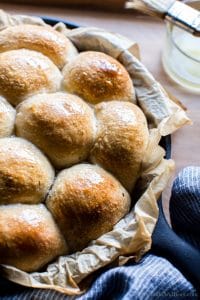
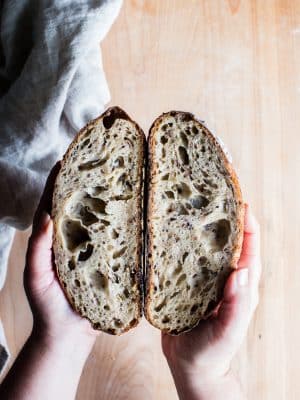
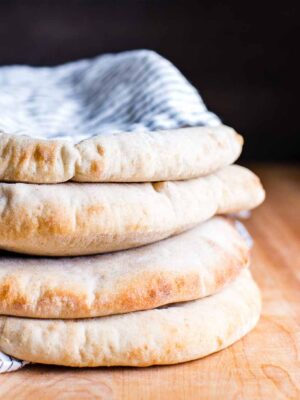

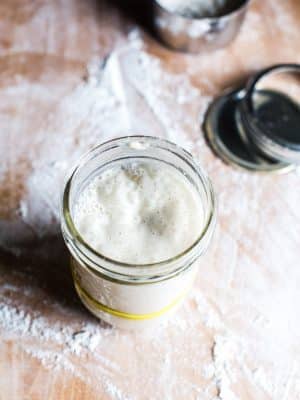
I’ve been making your seeded multigrain sourdough recipe regularly (thanks!) and thought I’d try these rolls. The dough went well, but I had problems baking. They took an extra 10 min to reach temperature and didn’t brown on top. I did bake on Christmas Day, so the oven was full of other dishes, which may have affected baking temps. Do the rolls need the egg wash to brown on top? I instead added melted butter after removing from the oven. I wanted to make sure the rolls shouldn’t be covered for part of baking, like the boule is?
Hi Laura! Thank you for your note and giving the recipe a go. It sounds like oven temperature may have been an issue. You do not need the egg wash to brown on top. In the video, the rolls are without egg wash – simply brushed with butter after they come out of the oven. Egg wash is an option, however if you want a shinyish/golden (less brown) finish. The rolls are not covered during baking. I hope this helps!
These came out great! Thank you so much for the recipe! love that is vegan friendly :)
Hi Traci…I make your multigrain seeded sourdough all the time and wanted to try these. I don’t know what happened to mine. I found it to be wetter than yours in the video and they didn’t rise as much and were doughy. Tasted good though. I will try again 🥰
Hi Laurie! It sounds like you may need to hold out some water and add to the dough as needed. Flours vary in their moisture content from brand to brand. Additionally, local humidity conditions will impact how your dough feels from one batch to another (or seasonally). Are you able to weigh your ingredients? Keep us posted!
These look great. I’m mixing up the dough tonight for a test before Thanksgiving. I’m going to try but do you think you could shape them into knots instead of rolls? I’m wondering how they would hold up and rise without being packed together. I’ll report back tomorrow I guess!
Hi Britta! Thank you for your note. What a terrific idea! I think they’d be delightful. keep us posted!
Oh your recipe sounds divine. I am a newbie at sourdough breads/rolls so I am depending on the Premium Instant Starter as I perfect a very active starter. What adjustments do I need to make to use this recipe with Instant Starter?
Hi Karol.. thank you for your note. The starter I use is 100% hydration. To replace that, you’d use 25g water and 25g flour. But, I don’t know how much Instant Starter you’d need. I’ve never worked with it, so, I’m unable to make a recommendation.
Thank you…. Now is the time to learn to make sourdough starter
I have a recipe for that: Sourdough Starter. Keep in touch, Karol and lmk if you have any Qs.
These were a huge hit with my family. Your detailed instructions really helped a lot and thanks to you baking with sourdough doesn’t feel so intimidating now. I’ve also been making your maple oat sourdough loaf weekly and it’s another great recipe. Thank you!
Hiii Marina! Thank you for your note and giving the rolls (and maple oat sourdough) a go! SO excited y’all enjoyed them and the instructions were helpful. Your feedback means a lot to me.
Is there harm in doubling the amount of starter in this recipe, or should it stay at 50g to ensure fluffy rolls? I have GI disorders and can only eat breads in sourdough form, but the recipes for bread I have made typically have 100g of active starter. Thank you :D
Hi Emma! While I’ve not tried it, and if you’re working with 100% hydration starter, I don’t see that it would be a problem. Keep us posted!
I tried the recipe using 75g of 100% hydration starter, and split it for half plain (egg washed), and half confit garlic and herb (buttered with Maldon flaked sea salt), baked on a sheet pan. They turned out amazing, thank you for the perfect recipe! Next time I will try it with 100g starter, as this has thus far been the magic amount for me to enjoy pain-free bread and pizza :-)
Hi Emma! Thank you for your note, sharing tips and success! SO happy to hear about pain-free bread and pizza !!
These rolls sound amazing, Tracy. Would you say that this recipe could be used as a burger/patty bun if baked on a sheet pan or is the texture too soft?
Sorry that I misspelled your name. It’s 5:30 in the morning!
Hi Camille! Thank you for your note. I’m thinking they’d be fine. Buns need to weigh about 130 grams each and gently flattened to 3 1/2 inches just before proofing, giving them plenty of room for expansion on the sheet pan. Let us know if you give it a go! No worries on my name, 5:30 is early!
Your sourdough rolls are so dreamy, Traci! Since it’s been so chilly lately, all I have on the brain is cozy, warm goodies! I would love one of these with a big schmear of butter
Hi Katherine! Neeed all the cozy food right now… and these are so good with a big schmear of butter (!!).
These look super fluffy and delicious Traci. I know Tom would LOVE them slathered with butter! Love the added herbs and garlic!
Slathered with butter FTW Mare! The garlic is SOOOO nice!